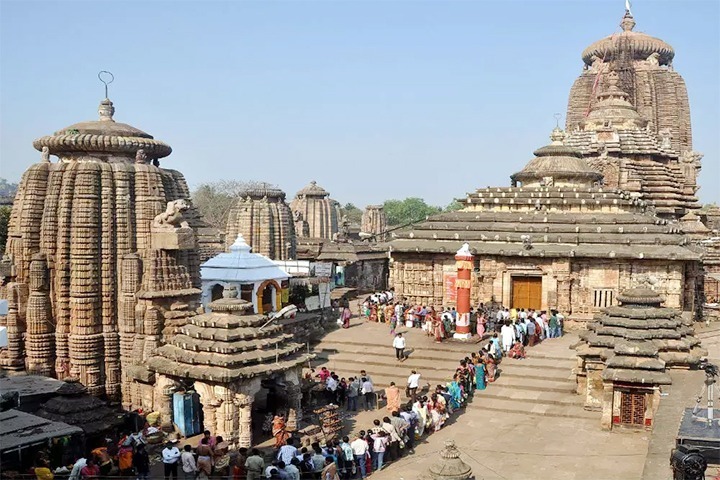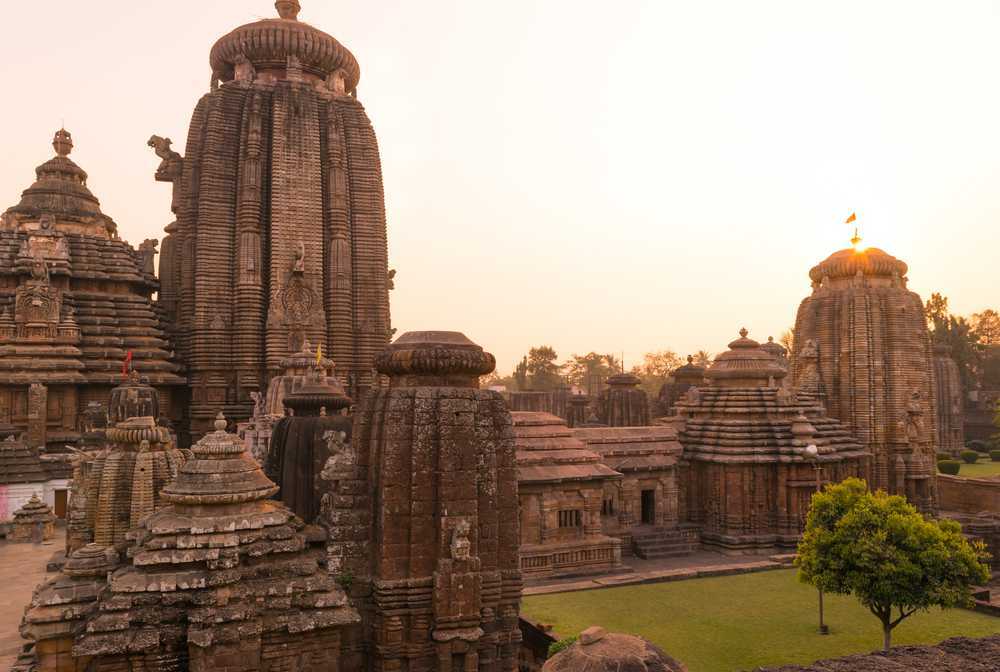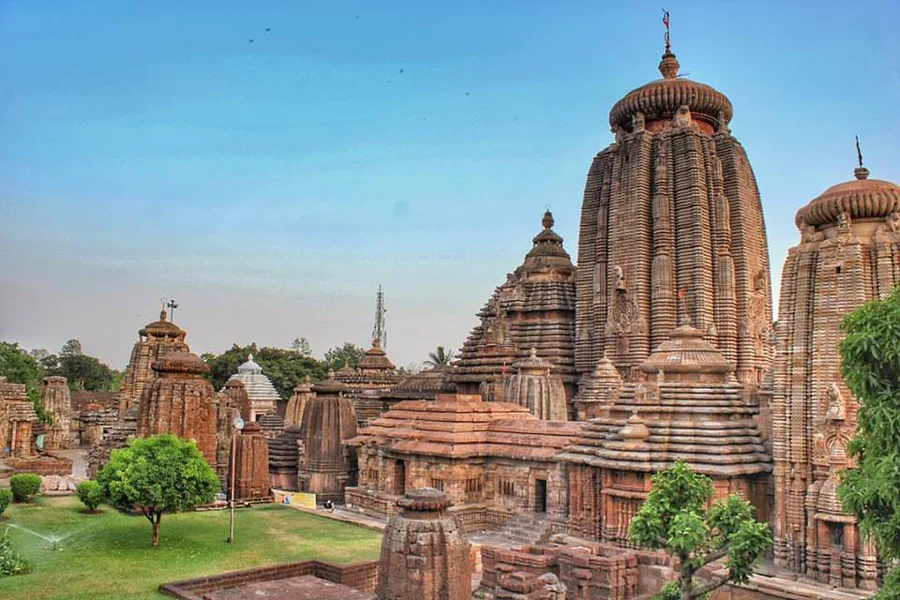
Lingaraj Temple, Bhubaneshwar, Odisha
The Lingaraja Temple, dedicated to Lord Shiva, is a renowned Hindu temple in Bhubaneswar, Odisha, India. Built in the 11th century by King Jajati Keshari, it stands as the city’s largest and oldest Hindu temple, attracting numerous tourists. With its towering height of approximately 54.8 meters, it houses a colossal granite statue of Lord Shiva, 8 feet in diameter, atop an elevated platform. Surrounded by 150 smaller temples dedicated to various Hindu deities, it is a symbol of the region’s rich cultural and architectural heritage, revered by devotees as “Swayambhu,” meaning “self-made Shivling.”
Namaste 🙏 नमस्ते
Secure your visit • अपनी यात्रा सुरक्षित करें
Historical background and Architectural splendor
The Lingaraja Temple, originally constructed in the 7th century and later rebuilt by King Jajati Keshari in the 11th century, is a testament to the rich cultural heritage of Bhubaneswar. Honoring both Lord Shiva and Lord Vishnu, it stands as the center of the Jagannath cult, featuring architectural elements such as the bhoga-mandapa, natamandira, jagamohana, and vimana. Renowned for its intricate sculptures and elaborate depictions of beings on its exterior walls, it portrays the combined form of Shiva and Vishnu, Harihara, with unparalleled grandeur.
Representing the distinctive Kalinga style, the Lingaraja Temple captivates with its architectural excellence and spiritual significance. From its open-air Natamandira and Bhoga Mandapa adorned with statues of Hindu deities to its intricately sculpted Jagamohana, the temple narrates tales from Hindu mythology and seamlessly integrates spiritual beliefs into every carving. With its timeless beauty, the Lingaraja Temple continues to inspire admiration from architects, historians, and devotees alike, standing as a remarkable tribute to the ingenuity of ancient Indian builders.

Religious Significance
Guru Nanak, the first Sikh guru, is said to meditate at the holy site where Harmandir Sahib was built. The sacred tank Amrit Sarovar was founded in 1577 by Guru Ram Das, the fourth Sikh guru. And the construction of the gurudwara was initiated by the fifth Sikh guru – Guru Arjan. Guru Arjan designed it to be built in the centre of the tank. The construction started in 1581 and took almost eight years to complete. Then, he installed the Adi Granth, the holy scripture of Sikhism, inside the temple. The Akal Takht in the complex was constituted by the sixth guru, Guru Hargobind. Guru Arjan was arrested by the Mughals after the construction. And Harmandir Sahib Amritsar fell into the hands of the enemy. Guru Gobind Singh liberated it later, in the 18th century. He was the tenth Sikh guru.After Guru Gobind Singh’s death, Harmandir Sahib had been under attack by Islamic rulers. It was in 1762 when this religious heritage was blown away. Maharaja Ranjit Singh rebuilt it in 1809 and adorned it with gold foil. Thus, Harmandir Sahib came to be called the Golden Temple.It was again destroyed in 1984 when the government wanted to capture militant Sikhs hidden inside. Later, from 1995 until 1999, it was rebuilt While the Golden Temple dome is made from pure gold, the inner walls and door panels also exhibit goldwork. Copper sheets have been engraved with delicate designs and then covered with gold leaves. Even the ceiling is adorned with precious stones and gold. The first floor of the Golden Temple is set up at a lower level below the ground. It’s decorated with rare paintings and marble sculptures. The stairs to the shrine go downwards, signifying humble living. It’s a blend of Indian and Mughal architectural styles. You’ll find symbolisms of life everywhere in Harmandir Sahib in Amritsar. They’re in paintings, in the form of birds, animals and flowers.

Festival and Celebrations
Here the festivals celebrated are Mahashivaratri,Ratha Yatra ,Chandan Yatra, Sitalsasthi Carnival, Kumar Purnima, Snana Yatra, Dola Yatra, Maha Navami, Shravana Purnima and Bhubaneswar Mahotsav.
Surroundings area & attractions
- Bindusagar Tank: Adjacent to the temple, this ancient tank is believed to contain holy water. It adds a serene atmosphere to the temple complex.
- Parasurameswara Temple: Located nearby, this temple is known for its unique sculptures and is one of the oldest in Bhubaneswar.
- Mukteshwar Temple: Another gem in the vicinity, this temple is renowned for its intricate carvings and architectural finesse.
- Rajarani Temple: Known as the "Love Temple," it boasts beautiful sculptural work depicting romantic themes.
FAQ
The Lingaraj Temple is located in Bhubaneswar, the capital city of the Indian state of Odisha. It stands as a significant landmark in the Old Town area of Bhubaneswar.
The presiding deity of the Lingaraj Temple is Lord Lingaraj, a form of Lord Shiva. The lingam (phallic symbol) representing Lord Lingaraj is enshrined within the sanctum sanctorum of the temple.
The Lingaraj Temple is one of the most prominent and revered temples dedicated to Lord Shiva in Odisha. It is considered a major pilgrimage site and an architectural masterpiece of Kalinga architecture.
The Lingaraj Temple is built in the Kalinga style of architecture, characterized by its towering spire (shikhara), intricate carvings, and sculptural embellishments. The temple complex also includes various other shrines, pavilions, and halls.
The Lingaraj Temple follows a strict schedule of rituals and ceremonies, including daily puja (worship), abhishekam (ritual bathing of the deity), aarti (ritual of worship with lamps), and special festivities on auspicious occasions and festivals dedicated to Lord Shiva.
Yes, the Lingaraj Temple is open to visitors of all faiths and backgrounds. Devotees and tourists are welcome to explore the temple complex and experience its spiritual and architectural splendor.
Visitors are encouraged to dress modestly and respectfully while visiting the Lingaraj Temple. Revealing clothing and attire that may be considered inappropriate for a place of worship should be avoided.
The Lingaraj Temple is open for darshan at specific timings throughout the day. Devotees can check the temple schedule for the darshan timings and plan their visit accordingly.
Yes, several festivals dedicated to Lord Shiva and other deities are celebrated at the Lingaraj Temple, including Maha Shivaratri, Kartik Purnima, and Shiva Ratri. These festivals attract a large number of devotees who come to seek the blessings of Lord Lingaraj.
Bhubaneswar is home to numerous other temples, heritage sites, and cultural landmarks that visitors can explore along with the Lingaraj Temple. Some notable attractions include the Mukteshwar Temple, Rajarani Temple, Udayagiri and Khandagiri Caves, and the Odisha State Museum.
The Lingaraj Temple dates back to the 11th century and is believed to have been constructed by the Somavamsi dynasty rulers. Over the centuries, the temple underwent various renovations and additions, contributing to its architectural grandeur.
The name “Lingaraj” is derived from two Sanskrit words, “Linga” and “Raja,” which collectively mean “King of Lingas.” It signifies the significance of the lingam (phallic symbol) as the primary representation of Lord Shiva worshipped in the temple.
The Lingaraj Temple exhibits several distinctive architectural features, including its towering spire (shikhara), intricate carvings depicting mythological themes and celestial beings, and the presence of numerous subsidiary shrines and pavilions within the temple complex.
According to legend, the Lingaraj Temple is believed to have been originally built by Lord Vishnu, with subsequent modifications and renovations carried out by various rulers and devotees over the centuries. The temple has several myths and folklore associated with its origin and significance.
Yes, visitors have the opportunity to participate in various special rituals and ceremonies conducted at the Lingaraj Temple, such as offering flowers, performing abhishekam (ritual bathing) to the lingam, and seeking blessings from the temple priests.
Photography may be restricted or regulated within certain areas of the Lingaraj Temple complex to preserve its sanctity and protect its heritage. Visitors are advised to inquire about photography guidelines and restrictions before taking pictures.
The Lingaraj Temple is managed and maintained by the Temple Administration Trust, which oversees its day-to-day operations, maintenance activities, and preservation efforts. Regular conservation initiatives are undertaken to safeguard the temple’s architectural and cultural heritage.
Yes, visitors have the option to hire local guides who are well-versed in the history, architecture, and significance of the Lingaraj Temple. These guides can provide valuable insights and enhance the visitor experience.
The Lingaraj Temple can be visited throughout the year, but certain festivals and auspicious occasions, such as Maha Shivaratri and Kartik Purnima, attract larger crowds of devotees and offer a vibrant atmosphere for visitors to experience.
Visitor information
Entry Fee: No fee
Timings :
- 6:00 am – 9:00 pm (Open)
- 12:30 pm – 3:30 pm (Closed)
Darshan Days- All days
Address:
Bhubaneswar, Orissa
Notable Events and Incidents
- The Lingaraja Temple hosts numerous festivals and celebrations, attracting devotees from across the region. Mahashivaratri is particularly significant, drawing large crowds for special rituals and processions.
- Cultural Significance: The temple has played a crucial role in preserving and promoting Odisha's rich cultural heritage, serving as a center for traditional music, dance, and art forms.
- Kalinga War Connection
Connectivity :
- By Air: The nearest airport to Lingaraj Temple is Biju Patnaik International Airport in Bhubaneswar, located about 4 kilometers away. From the airport, visitors can hire taxis, autos, or app-based cabs to reach the temple quickly and comfortably.
- By Rail: The closest railway station is Bhubaneswar Railway Station, approximately 3 kilometers from the temple. From the station, one can easily hire autos, taxis, or take local buses to reach the temple premises.
- By Road: Bhubaneswar is well-connected by road to major cities in Odisha and neighboring states. The temple is easily accessible from all parts of the city through local buses, autos, and taxis, with smooth access via NH16 and the city’s internal road network.
